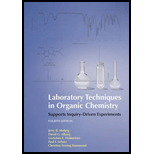
Interpretation:
The reason for the use of silica gel columns with smaller particle sizes in chromatographic separation should be stated.
Concept introduction:
Liquid chromatography is used for purification of high boiling compounds. It is known as column chromatography. In liquid chromatography, column is packed by stationary phase. Usually, a solid adsorbent with a liquid coated on it is used as stationary phase. Often a pure liquid or solution of liquids composes the mobile phase. It is also called the elution solvent.
The elution solvent comes down the column under the influence of gravity. Selective interactions are responsible for separation of the sample among stationary and mobile phase. The sequence of elution of compounds from sample depends on the polarity of mobile and stationary phases.
Want to see the full answer?
Check out a sample textbook solution
Chapter 19 Solutions
Laboratory Techniques in Organic Chemistry
- K Draw the starting structure that would lead to the major product shown under the provided conditions. Drawing 1. NaNH2 2. PhCH2Br 4 57°F Sunny Q Searcharrow_forward7 Draw the starting alkyl bromide that would produce this alkyne under these conditions. F Drawing 1. NaNH2, A 2. H3O+ £ 4 Temps to rise Tomorrow Q Search H2arrow_forward7 Comment on the general features of the predicted (extremely simplified) ¹H- NMR spectrum of lycopene that is provided below. 00 6 57 PPM 3 2 1 0arrow_forward
 Principles of Instrumental AnalysisChemistryISBN:9781305577213Author:Douglas A. Skoog, F. James Holler, Stanley R. CrouchPublisher:Cengage Learning
Principles of Instrumental AnalysisChemistryISBN:9781305577213Author:Douglas A. Skoog, F. James Holler, Stanley R. CrouchPublisher:Cengage Learning EBK A SMALL SCALE APPROACH TO ORGANIC LChemistryISBN:9781305446021Author:LampmanPublisher:CENGAGE LEARNING - CONSIGNMENT
EBK A SMALL SCALE APPROACH TO ORGANIC LChemistryISBN:9781305446021Author:LampmanPublisher:CENGAGE LEARNING - CONSIGNMENT


